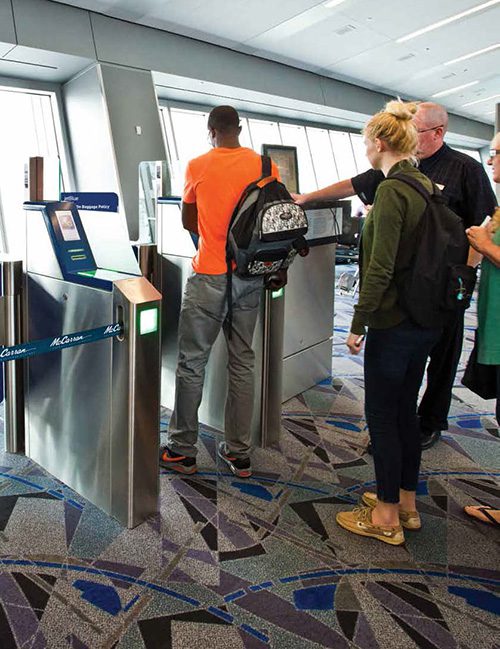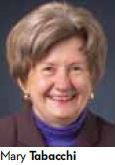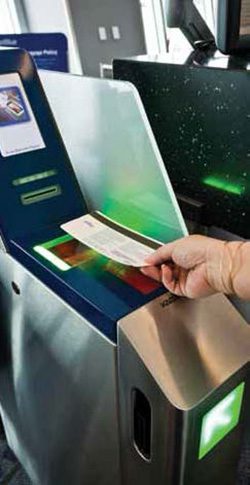 After approximately 18 months with new self-boarding gates operating in Terminal 3 at McCarran International Airport (LAS) in Las Vegas, sources there report that the state-of-the-art machines have been well received by both airlines and passengers.
After approximately 18 months with new self-boarding gates operating in Terminal 3 at McCarran International Airport (LAS) in Las Vegas, sources there report that the state-of-the-art machines have been well received by both airlines and passengers.
Travelers using the new gates scan their own boarding passes, instead of handing them to gate agents.
The self-boarding machines, by Kaba Access and Data Systems, were installed at all 14 gates in the new terminal, with two machines per gate. The equipment accepts paper passes and passes on customers’ smartphones. The setup and placement of the machines was taken into account when the new terminal was being designed, notes Samuel G. Ingalls, assistant director of aviation, information systems at LAS. “The layout needed to be well-planned, with plenty of space and room for a straightforward flow,” Ingalls explains.
The new self-boarding system allows gate agents to spend more time assisting passengers who really need their help, he notes. “There is a false impression that self-boarding gates are unattended. This is not true,” clarifies Ingalls. “In fact, we designed it so the gate agent is actually much closer to the self-boarding machine, perhaps 5 feet away instead of 20 feet away. If a passenger has a problem, he or she can simply move one step to the side and talk to the agent, and then get back in line, without having to go to the back of the line.”
|
factsfigures
Project: Self-Boarding Gates |
The cutting-edge equipment allows airlines to better utilize their gate agents’ skills, he adds: “These agents get a lot of training, and are capable of doing many more things besides simple scanning.”
In or Out?
At LAS, airlines can choose if and how they want to use the self-boarding gates, depending on their particular needs. Terminal 3 serves international and domestic carriers, and is equipped to accommodate both narrow and wide-body aircraft.
JetBlue Airways was one of its early adopters. Alaska Airlines did a pilot trial, and is currently reviewing the results. In the meantime, other airlines are continuing to monitor the viability of self-boarding.
“Delta did a trial, and I watched several planes board during that period,” Ingalls reports. “People were interested; they liked to try something new. Any frequent traveler would embrace it.”
He also gained the passenger perspective last year: “I was going through Houston, on the way back to Las Vegas, and United was doing a self-boarding trial. It worked very well. I also know that Continental was doing a lot of trials, before they merged with United.”
Other airports, including Mineta San Jose International in California, are also testing the new machines.
At LAS, international carriers have been slower to adopt the technology, because of the challenges involved with checking passports, visas, etc. Pilot trials, however, are scheduled for the first half of the year.
So Far, So Good
As of early December, LAS had not experienced any security issues associated with its new self-boarding gates. “I believe they can actually enhance security,” says Ingalls. “Gate agents can make mistakes boarding several planes a day. Sometimes, after checking hundreds of passengers a day, they may miss the red warning light that comes on with a faulty boarding pass. And every day, people continued to get on the wrong plane.”
While some passengers may lament the lack of human contact, representatives of the equipment manufacturer contend that self-boarding gates actually improve customer experience. “Gate agents will be able to provide better customer service,” explains David Wurtz, Kaba’s director of business development. “Just last month, I got stranded in Milwaukee due to an ice storm in Dallas, and could not get home. I was lucky and got a good gate agent to help me. But if she were busy scanning boarding passes, I would have had to wait much longer.”
According to Kaba studies, its machines can cut boarding time in half. “It takes 25 minutes to board a 737 — the workhouse of the industry,” Wurtz notes. “With self-boarding, it can take just 12 minutes.”
Company research also shows that 85% of passengers surveyed prefer the self-service option. “I am an executive platinum member with American,” comments Wurtz. “I fly a lot, and really don’t need a gate agent.”
Although some unions have expressed concern about job loss, he does not believe that will be the case. “I have not yet heard of anyone losing a job over this new system,” he reports. “You will always need a gate agent. Some people will need help, such as those in wheelchairs, or elderly people.
Airlines also want to continue to cater to premium customers, who want to board first to get overhead bin space. So gate agents are needed for that.”
Mary Tabacchi, a professor with Cornell University School of Hotel Administration, is another self-boarding advocate. “In general, anything to speed up the boarding process is good,” says Tabacchi, who has taught an airline management course for several years. “It saves airlines and the airport time and expense.”
According to Tabacchi, self-boarding is the wave of the future. “Lufthansa and several international airlines are doing it,” she notes.
Passenger acceptance, she adds, will largely depend on the age of a given traveler. “People under 40, like my students, will be thrilled,” she explains. “They grew up in an electronic age. But as people get older, they prefer more human interaction. McCarran still has people at the gate to help passengers.”
Tabacchi also expects the cultures of various airlines to influence deployment trends. She expects self-boarding gates to be a good fit for JetBlue Airways, because of its “certain hipness.”

“Many people print out their boarding passes from their office or home printers, and are doing that more and more. We will all get used to self-boarding,” she predicts.
Ingalls shares Tabacchi’s perspective. “When self-service kiosks first came out in 2003, it took people awhile to accept them,” he recalls. “Now, 10 years later, some 75 million people have used kiosks at McCarran to get their boarding passes.”
Self-boarding gates are well established at several European airports, and Wurtz believes it is only a matter of time before they become more popular in the United States. “The larger international airlines, such as British Airways and Lufthansa, are big advocates of self-boarding gates,” he reports. “Also, with passengers needing to get to airports farther in advance than ever, anything to get them on board faster will be appreciated.”


